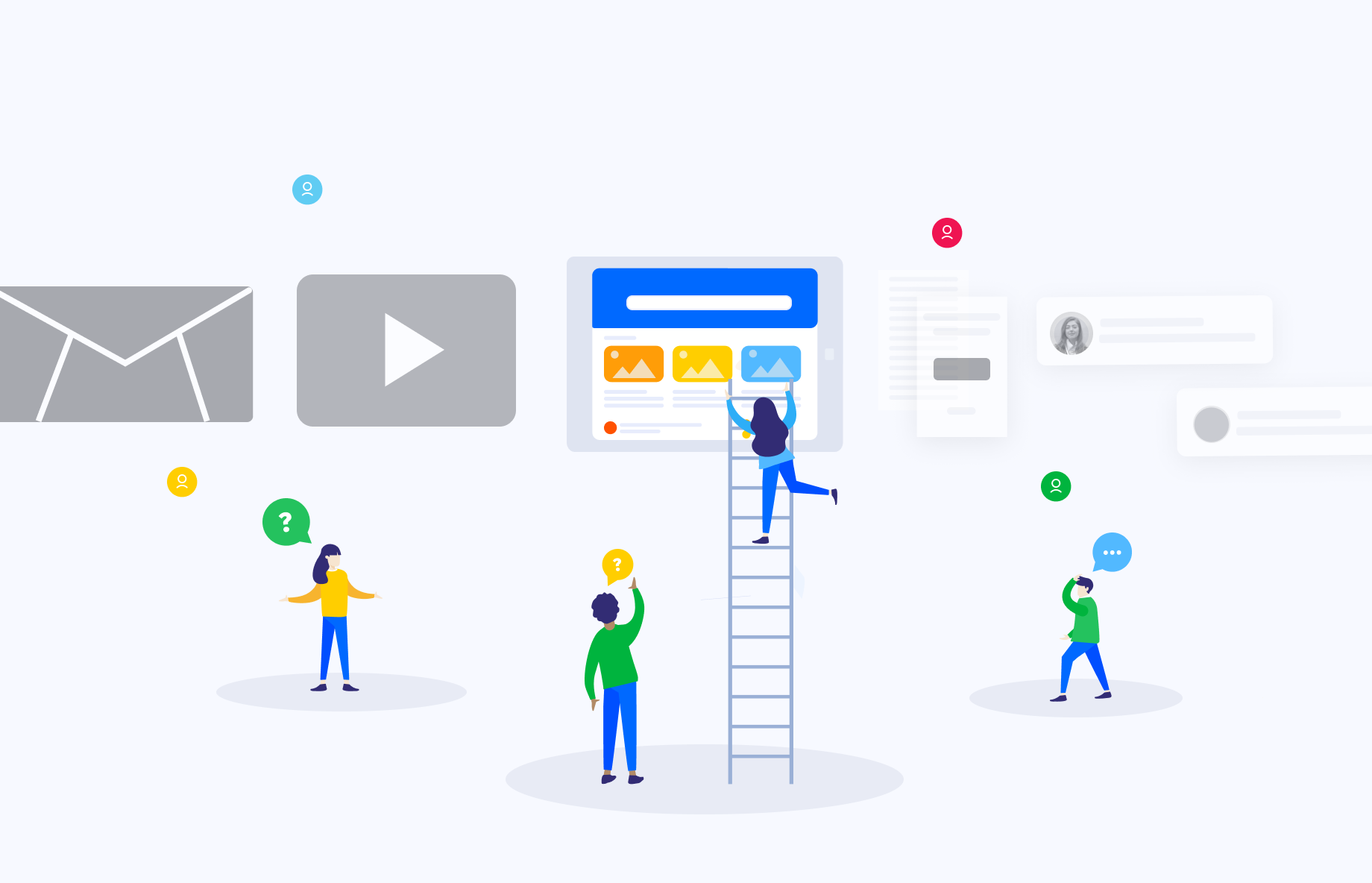Welcome to the fourth installment in our new series, This is Digital Customer Success where we set out to get clarity on all things Digital CS. In our first post, we started off by defining Digital Customer Success and explained how it’s different from “traditional” Customer Success. Next, we dove into the core components of Digital Customer Success and most recently we walked you through a new way of mapping out the customer journey. This week, it’s time to take a closer look at channels.
You’ve done it. You’ve completed the first and (arguably) most crucial step in building your Digital Customer Success program: you’ve mapped out the customer journey.
You have a roadmap for what behaviors need to be achieved in a given timeframe. Now it’s time to start thinking about the digital channels that will help drive those behaviors.
So the question is, where do you start? Well, as always, you start with your roadmap.
Audit existing behaviors and channel performance
When you start developing the channels for your digital CS program, there are a couple of things you need to think about:
- What channels are you currently using and which ones work well for you?
- What channels could be the most effective in driving the behaviors you’ve identified?
This is when you go back to your roadmap and carry out an audit. Look at the key behaviors and ask the following questions:
- What actions did customers take in order to achieve those key behaviors?
- What channels did they use? Is there a pattern?
- What type of content did they engage with? Did that content cover certain sections of your product or areas of interest? And what can you learn from that?
If you have enough data to identify trends then use that data as a baseline to develop your channels and the content you’re pushing through them. If your Customer Success organization is less mature, start simple (more on this below!), work with what you have, and iterate as you learn more about your customers and their preferences.
Developing channels for your digital CS program
One of the most important aspects of Digital Customer Success is to have the resources in place for customers to self-serve. Your customers don’t want to get in touch with your CSMs for every little question they have, and your CSMs need time to focus on high-value conversations.
When it comes to developing your digital channels, one thing to bear in mind is this: Every touchpoint is an experience. The goal? To make every experience through those touchpoints a positive one while your customers are working toward the key behaviors.
So how do you choose the most effective channels? Yes, you guessed it. It starts with the customer.
Choosing the most effective channels
Ask your customers
Always ask your customers what works for them. Do they want email prompts? In-app guides? Or are they perhaps happy to self-serve using a knowledge base? There’s never a wrong time to ask customers about their communication preferences, do it consistently to understand how preferences might change as they mature with your product. E.g once the onboarding process has been completed, send out a survey asking if they had all the resources they needed, and if not what were they missing?
Opt for easy over effective
A full-fledged digital CS program is typically centered around a resources hub such as a learning management platform, help center, or a community platform where you centralize all of your customer success content. But if you’re just getting started, simply start with addressing the common questions and pain points in the quickest and most accessible format, e.g. help articles. To have resources in a format is better than no resources at all.
Value over production
Now, articles might be the quickest content to get out the door and publish in your FAQ section or your help center. But that doesn’t mean you have to shy away from including other types of content in those channels. There’s a lot of snazzy videos in SaaS, from product tours to feature walk-throughs and how-tos. But a simple screen record can bring clarity and add the value customers are looking for. The point being, don’t get too caught up in cosmetics! Think about what the learning value is rather than what something looks like.
The more channels, the better
When you can, add more channels to the mix. If you only focus on one channel or one type of content, it’s easy for customers to miss it. Plus, it might be delivered in a format that doesn’t work for them. As Ângela Guedes, Head of Customer Success at Belvo puts it, “Digital Customer Success is about delivering the right content to the right people at the right time.” As you add more channels, think about the narrative your customer is experiencing, and the timing of that narrative.
Evaluate your tech stack
Your channels will only be as good as your tech stack. And your tech stack will only be as good as your budget. An issue for Customer Success historically has always been the lack of purpose-built tools. They’ve had to borrow tools from other departments and make do. But as Digital Customer Success finds itself at the intersection of Support, Marketing, Sales, and Product – this is suddenly where the past borrowing becomes a blessing. As Customer Success adopts more and more marketing and product metrics as their own, their tech stacks also need to reflect this. And while your tech stack is likely to change over time, the best tech stack is one that scales as you scale. (Psst! You can read more about building your CS tech stack in this eBook.)
Clarify ownership
But it’s not just about choosing the most effective channels – it’s just as much about using them effectively. That’s why, before anything else, you need to clarify ownership. Whose responsibility is it to build out the digital channels? Who’s the best person to create the content? This mostly comes down to resourcing. In a smaller company, it’s likely to be one single person, whereas in a larger company the responsibility would stretch over a set of teams, such as Customer Success, Customer Marketing, and Product.
Track, measure and test everything
In a Digital Customer Success program, data is in the driver’s seat. Whatever channels you choose, you need to make sure that everything can be tracked so that you can measure impact and keep improving. Engagement metrics are the starting point for driving specific behaviors. E.g if your customer opens an email, but doesn’t take an action, you have to evaluate why that didn’t happen. Was it unclear what they were supposed to do? Was it the wrong action? The point in the experience where the engagement and the behavior stops, that’s where you’ll need to investigate why. (We’ll talk more about leveraging data in next week’s post!)
Start simple
The key to getting started is trying to not overthink your channels or your content. Think about the behavior you need to drive and what could the best channel for the job. If your customers are already engaged with your emails, start there. If your customers spend more time on your blog or in your knowledge base, start there. Wherever your customers spend most of their time engaging with content, that’s your starting point.
5 things to consider when you’re building out your channels
- Think about your channels from your customer’s perspective. Ask your customers what channels and interactions they prefer.
- View every touchpoint as an experience. Whether it’s an in-app prompt, webinar, or knowledge base article, look at it as an experience that should achieve a specific outcome.
- Look at what channels currently work well. Do your customers engage with emails? Do they visit the knowledge base? Do they spend most of their time in your product?
- Be strategic in the way you combine channels. The purpose of your channels and content is to enable customers and help them self-serve, not overwhelm them.
- Be transparent with your customers in what you want them to do. When you see that customers don’t meet specific data points, let them know.
Final words
A fully developed Digital Customer Success program consists of channels and content that allow customers to onboard, adopt, and get to a high level of maturity with no human intervention whatsoever. And while that might sound like quite a feat, the truth is that, well, it isn’t. Why? A lot of today’s professionals are digital natives. We’re used to working in the cloud. Plus, most of us don’t just want automation – we expect it. Customers often like to create their own experience and they don’t want our help. However, our job is still to guide them toward meeting the behaviors we have identified as achieving value for them.
Next week, we’ll dive deeper into channels and talk more about leveraging data. Subscribe to our blog to make sure you don’t miss it!
In the meantime, here’s some content you might want to dig into:


